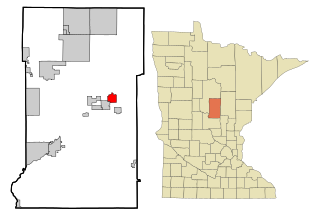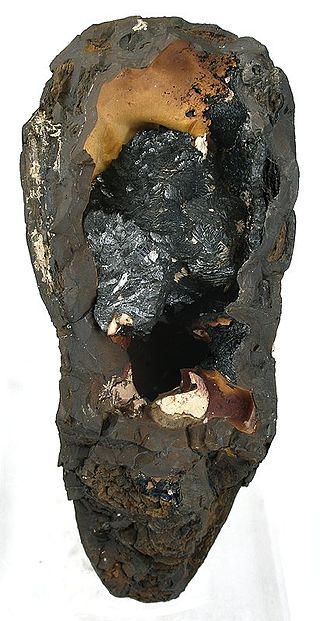Related Research Articles

Crosby is a city in Crow Wing County, Minnesota, United States. The population was 2,386 at the 2010 census. It is part of the Brainerd Micropolitan Statistical Area. Crosby is adjacent to its twin city of Ironton, in the Cuyuna iron range.

Cuyuna is a city in Crow Wing County, Minnesota, United States. The population was 332 at the 2010 census. It is part of the Brainerd Micropolitan Statistical Area.

The term Iron Range refers collectively or individually to a number of elongated iron-ore mining districts around Lake Superior in the United States and Canada. Much of the ore-bearing region lies alongside the range of granite hills formed by the Giants Range batholith. These cherty iron ore deposits are Precambrian in the Vermilion Range and middle Precambrian in the Mesabi and Cuyuna ranges, all in Minnesota. The Gogebic Range in Wisconsin and the Marquette Iron Range and Menominee Range in Michigan have similar characteristics and are of similar age. Natural ores and concentrates were produced from 1848 until the mid-1950s, when taconites and jaspers were concentrated and pelletized, and started to become the major source of iron production.

The Vermilion Range exists between Tower, Minnesota and Ely, Minnesota, and contains significant deposits of iron ore. Together with the Mesabi and Cuyuna Ranges, these three constitute the Iron Ranges of northern Minnesota. While the Mesabi Range had iron ore close enough to the surface to enable pit mining, mines had to be dug deep underground to reach the ore of the Vermilion and Cuyuna ranges. The Soudan mine was nearly 1/2 mile underground and required blasting of Precambrian sedimentary bedrock.

The Cuyuna Range is an inactive iron range to the southwest of the Mesabi Range, largely within Crow Wing County, Minnesota. It lies along a 68-mile-long (109 km) line between Brainerd, Minnesota, and Aitkin, Minnesota. The width ranges from 1 to 10 miles.

Cuyuna Country State Recreation Area (CCSRA) is a state park unit of Minnesota, USA, being developed to rehabilitate a portion of the Cuyuna Range where mining pits and piles of waste rock were left behind after decades of open-pit mining for iron ore. Abandoned by mining companies more than 20 years ago, the state recreation area consists of regenerated vegetation and clear lakes that draw a wide range of recreation enthusiasts. The park is located off Minnesota State Highway 210, near the towns of Crosby, Ironton and Cuyuna. The Croft Mine Historical Park, formerly city-run, is now part of the state recreation area.

Portsmouth Mine Pit Lake, sometimes called the Portsmouth Pit, is the deepest lake completely within the state of Minnesota, USA. It has a depth of over 450 feet (137 m), according to the most recent Minnesota DNR data. Lake Superior, over 700 feet deep off the north shore of the state, is technically deeper. The 120-acre (49 ha) artificial lake is a former iron mining pit in the Cuyuna Range that has since filled with water.

Crosby station is a historic former train station in Crosby, Minnesota, United States. It was established in 1910. It was listed on the National Register of Historic Places in 1980 as the Crosby Railroad Depot for having local significance in the themes of commerce, industry, and transportation. The depot was nominated for being an essential conduit for the arrival of goods and people and the export of iron ore during central Crow Wing County's economic boom years.

Manganese is a ghost town and former mining community in the U.S. state of Minnesota that was inhabited between 1912 and 1960. It was built in Crow Wing County on the Cuyuna Iron Range in sections 23 and 28 of Wolford Township, about 2 miles (3 km) north of Trommald, Minnesota. After its formal dissolution, Manganese was absorbed by Wolford Township; the former town site is located between Coles Lake and Flynn Lake. First appearing in the U.S. Census of 1920 with an already dwindling population of 183, the village was abandoned by 1960.

The Artillery Mountains are a mountain range in Mohave County in western Arizona. High point of the range is Artillery Peak, 2,917 feet above sea level. Artillery Peak is at coordinates N 34.36946 W 113.58160.

Metal production, in particular iron and steel industry, is the dominant heavy industry in Ukraine. Ukraine is the world's eighth largest producer and third largest exporter of iron and steel (2007). Ukrainian iron and steel industry accounts for around 2% of worldwide crude steel output, 5% to 6% of the national gross domestic product and 34% of Ukrainian export revenue. In 2007 it employed 420,000 people – 10% of industrial labor and 2% of the total workforce. It has the highest, by a wide margin, revealed comparative advantage of all branches of the Ukrainian economy. The industry peaked at 42.8 million tonnes in 2007 but has been gravely affected by the financial crisis of 2007–2010 and declined to 29.8 million tonnes in 2009.
The Răzoare mine was a large mine in the north of Romania in Maramureș County, 43 km (27 mi) southeast of Baia Mare and 507 km (315 mi) north of the capital, Bucharest. Răzoare represents one of the largest manganese reserve in Romania having estimated reserves of 5 million tonnes of manganese.
The Globurău mine is a large mine in the west of Romania in Caraș-Severin County, 29 km (18 mi) north of Orșova and 392 km (244 mi) west of the capital, Bucharest. Globurău is one of the largest manganese reserves in Romania, with estimated reserves of 3 million tons of manganese.

Ironton Sintering Plant Complex is a group of buildings north of Crosby, Minnesota, United States, listed on the National Register of Historic Places. The plant was built in 1924 by the Hanna Mining Company to sintering iron ore mined in the Cuyuna Range. The mining industry, after 1900, was seeking to exploit lower-grade iron deposits to meet the increasing demand of the iron and steel industry. To bring the ore to customers' specifications, the mines sought to "beneficiate" the ore through sintering, crushing, and washing. The sintering process was unique to the Cuyuna Range and made it possible to economically support mining.

Groutite is a manganese oxide mineral with formula Mn3+O(OH). It is a member of the diaspore group and is trimorphous with manganite and feitknechtite. It forms lustrous black crystals in the orthorhombic system.
This list of mines in the United States is subsidiary to the list of mines article and lists working, defunct and future mines in the country and is organised by the primary mineral output. For practical purposes stone, marble and other quarries may be included in this list.
The Rudăria-Bănia mine is a large open pit mine in the south-western Romania in Caraș-Severin County. Rudăria-Bănia represents one of the largest iron ore reserves in Romania having estimated reserves of 70 million tonnes of ore grading 45% iron metal and 20% manganese metal. The mine has the capability to produce around 500,000 tonnes of iron ore/year.
The Artillery Peak mine is a mine located in the western United States, about 3 miles (4.8 km) north of Alamo Lake in Mohave County, Arizona. Artillery Peak represents one of the largest manganese reserves in the United States, with estimated reserves of 159 million tons of manganese ore graded 3.9% manganese metal.
The Batesville mine is a mine located in the midsouth of the United States in Arkansas. Batesville represents one of the largest manganese reserve in the United States having estimated reserves of 178 million tonnes of manganese ore grading 4% manganese metal.

The Milford Mine produced high manganese-content iron ore in Wolford Township, Minnesota, United States. On February 5, 1924, it was the site of the Milford Mine Disaster, the worst mining accident in Minnesota history, when it was flooded by water from a nearby lake, killing 41 miners. Only seven men were able to climb to safety. Starting in 2010, the site has been under development by Crow Wing County as Milford Mine Memorial Park. The property was listed as the Milford Mine Historic District on the National Register of Historic Places in 2011 for its state-level significance in the themes of industry and historical archaeology. It was nominated for its association with a significant event in Minnesota history, and for potential archaeological resources that could illuminate mining technology, the rise and fall of iron-ore mining on the Cuyuna Range, and the daily lives of its workers.
References
- ↑ Manganese Reserves and Resources of the World. Washington DC: National Academies. 1981. pp. 334.
mining in MOROCCO reserves.